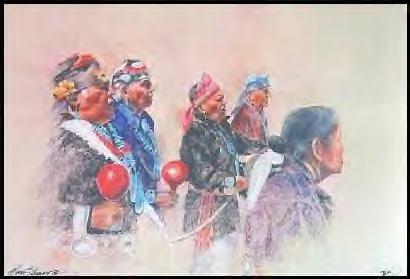|
|
Canku Ota |
|
|
(Many Paths) |
||
|
An Online Newsletter Celebrating Native America |
||
|
September 6, 2003 - Issue 95 |
||
|
|
||
|
Saving Culture Depends on Saving Languages |
||
|
by Dorreen Yellowbird Grand
Forks Herald
|
||
|
The medicine man's refusal to teach his ceremony to these young men because they weren't fluent in the language resulted in his way of the ceremony being lost. One of my aunts, who is Catholic but also believes in the Native way of life, said that the ceremonies shouldn't be limited to the Native language. Certainly, God wouldn't understand only one language, she said. She has a good point that is difficult to counter.When the issue of whether the Creator could understand all languages was asked of my uncle, he said, yes, their God, our Creator, the Supreme Being is powerful. It is we who might have difficulty communicating with the Spirit because different languages differ in impact and meaning. Take, for example, a joke told in Sahnish and then retold in English. In the Sahnish language it is funny, but when translated it loses its punch - the translated words just don't provide the same meaning. So, when we talk to the Creator in a language different than how we were taught, the meaning may change, he said. The Creator does understand all languages, but the ceremonies were given to us in Sahnish and are best practiced that way, he told me. That communication dilemma is reaching a critical point on many reservations. In fact, on some reservations, the language has all but disappeared. There are programs on many reservations to teach the young. My grandsons and granddaughter are learning the Dakota language in a Sisseton, S.D., school. I am amazed to hear my grandsons rattle off Dakota as easily as English. They are young and at an age where learning a language isn't difficult, but when these children go home, the adults - the generations who were indoctrinated into the white way - don't speak the language. The learning stops when school is out and after awhile, the children start to forget. In order for a language to thrive, it must be used and spoken regularly. Of course, we are in an English-speaking world. Most of us live our lives in English. But that isn't how it was 30 or 40 years ago, when Native languages were common and less influenced by the media and society. My father used to say that he dreamed in Sahnish. He spoke the Indian language of the tribes in the Dakotas and was fluent in all four. His English was poor. He said he had to listen to the English word and translate it in his mind. There were too many foreigners, he called them, whose language was influencing his family and the people. He was right. Learning and understanding the language is important not only so that those who wish to follow the Native way can participate, but also in order to gain a clear understanding of the culture - our way of life. One of the ways that this "language saving" is happening on some reservations came from Arvol Looking Horse, the Keeper of the White Buffalo Calf Peace Pipe, and other spiritual leaders and elders who said Native ceremonies should be conducted in the Native language. If you don't know the language, you can participate only on the periphery of the ceremony, they said. There was a lot of grumbling and naysaying around the reservations about that decision, but there also are a lot more people who have begun to learn the language. In order to participate in ceremonies, they said, it is important - so learn it. It is a tough and defining time for maintaining the languages of the 540-plus tribes in this nation. We are at a crossroads but the word is out. Understanding the language is important for maintaining the ceremonies, and the language has crucial ties to the culture of past generations. That culture, in turn, is important to the future of Native people. |
|
|
||
|
|
||
| Canku Ota is a free Newsletter celebrating Native America, its traditions and accomplishments . We do not provide subscriber or visitor names to anyone. Some articles presented in Canku Ota may contain copyright material. We have received appropriate permissions for republishing any articles. Material appearing here is distributed without profit or monetary gain to those who have expressed an interest. This is in accordance with Title 17 U.S.C. Section 107. | ||
|
Canku Ota is a copyright © 2000, 2001, 2002, 2003 of Vicki Lockard and Paul Barry. |
||
 |
 |
|
|
The "Canku Ota - A Newsletter Celebrating Native America" web site and its design is the |
||
|
Copyright © 1999, 2000, 2001, 2002, 2003 of Paul C. Barry. |
||
|
All Rights Reserved. |
||
 My
uncle, a prominent medicine man, died about 14 years ago. When
he died, he took his knowledge of an important Sahnish or Arikara
ceremony with him. He told several young men, who were trainees,
that for him to teach them this ceremony, they needed to know
the Sahnish language. They knew only "words" and not
the speaking language.
My
uncle, a prominent medicine man, died about 14 years ago. When
he died, he took his knowledge of an important Sahnish or Arikara
ceremony with him. He told several young men, who were trainees,
that for him to teach them this ceremony, they needed to know
the Sahnish language. They knew only "words" and not
the speaking language.